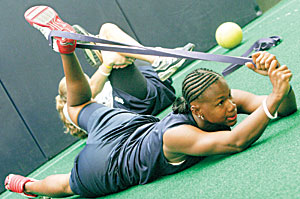 |
|
Jacob Konst/Arizona Daily Wildcat
|
Women's basketball guard Natalie Jones, a family studies and human development senior, stretches before weight training over the summer in McKale Center. Athletes undergo a comprehensive physical before beginning to participate in athletics at the UA. The athletes are also tested for drugs like steroids.
|
|
|
By Danielle Rideau
Arizona Daily Wildcat
Thursday, October 6, 2005
Print this
Official review begun after Polk's collapse
Arizona Athletics officials said they do not see a need to change health standard tests despite two student-athlete deaths in the last 16 months.
The athletics department doesn't think its testing standards are related to the June 8, 2004, death of UA football player McCollins Umeh or the Sept. 26 death of UA women's basketball center Shawntinice Polk, said Kathleen "Rocky" LaRose, senior associate director of athletics.
When an athlete is injured or dies, the department reviews the circumstances and decides if any changes in procedures or policies are necessary, LaRose said.
"When anything happens, we routinely review the situation, and if there is something that needs to be changed, we change it," LaRose said.
LaRose could not comment on Polk's death because of Health Insurance and Portability and Accountability Act regulations, but said student-athletes can only participate in sports after they have passed standards from the American College of Sports Medicine's book "Preparticipitation Physical Evaluation, Third Edition."
When athletes come into the department as freshmen they must pass an extensive physical exam to get clearance to participate, LaRose said.
The "extensive" exam involves physicians who administer physicals and listen to the athlete's heart, test blood pressure and test eyesight, among other common tests in physical exams, LaRose said.
Student-athletes must also complete written health and family history forms, she said.
"When they come in as freshmen, their physical exams are more detailed because we don't know them," LaRose said. "We take a very detailed history of them and we have a written (evaluation), and if anything looks awry we study it further."
Kenny Frank, a member of the cross country and track teams, said when he was a freshman he was seen by a physician and had his eyesight tested as well as having his heart and pulse listened to. The department also asked him for a past history of injuries and illness.
Because of a condition Frank had with his heart in high school, he said, the department asked him to stay out of practice until a doctor could evaluate him further.
Returning student-athletes must also take physicals to compete in the following years, but those tests aren't as extensive because the department already knows the athlete and their health history, LaRose said.
Returning athletes still have written questionnaires to fill out, and they have their height, weight and blood pressure checked. The athlete can only participate after getting clearance from the physician, LaRose said.
"If anything comes up from the (evaluation), then we do follow-up testing," she said.
Eric Chavez, a member of the track and cross country teams, said he did not see a doctor when he returned for his second season, but the trainers tested his blood pressure, eyesight and heart.
After getting approval to compete, the athlete is still monitored by the training staff to ensure they are still in good physical condition, LaRose said.
The department has a team physician, Dr. Don Porter, who has hours set aside to see athletes for injuries. Each team also has trainers who attend their games and practices, LaRose said.
Porter said he could not comment about student-athlete training, saying all questions had to be referred to LaRose.
Beyond having a team of physicians, the department offers medically trained athletic trainers and physical therapists as well as medical emergency equipment, emergency medicines on hand and 13 automated external defibrillator machines, LaRose said.
"Our athletes are interfacing with medical staff more in one week than regular students are in one year," LaRose said.
The athletics department keeps up with the daily changes of medicine and keeps the staff current on medical advancements, she said.
"Medicine changes daily, so our team physicians and consultants are being educated daily as medicine and treatments change," LaRose said. "We keep up with what's happening in the nation and the medical journals."
Student-athletes are also tested for "all street drugs and performance enhancing drugs" by the athletics department and the NCAA, LaRose said.
The unannounced drug and alcohol tests occur a few times a year, she said.
